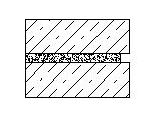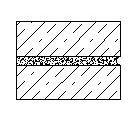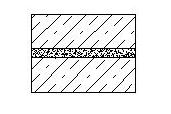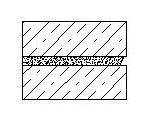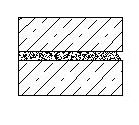Have you identified fretting mortar around your property? Re-pointing mortar joints
Fretting mortar is essentially when the mortar between the bricks begins to crumble or fall away. Visit our technical information on fretting mortar for more information on the causes, as this blog will focus on the repair itself. Repair is usually inexpensive and can be undertaken by a competent bricklayer.How do I re-point mortar joints?
It should first be noted that although re-pointing of mortar is a relatively straight-forward process, a competent professional should always be engaged. Additionally, if the mortar is found to have deteriorated right-through the brick joint or defective cement products were used, re-laying may be required. The following steps should be taken to ensure complete repair of mortar joints:Firstly all damaged mortar joints should be suitably ‘raked out’. This process involves the use of a raking tool, or mechanical means such as a grinder. If a grinder must be used ensure that PPE is worn and all Occupational Health and Safety requirements are fulfilled. The depth of damaged mortar that has to be removed is dependent upon the severity of the damage, although as a guide a minimum of 50mm should be removed. This allows for re-adhesion of the new mortar to the old, and prevents discolouration with the existing.
Secondly, the affected area should be cleaned free of dust. This is also to ensure that the new mortar does not separate from the old. Dependent upon the weather conditions, the existing affected area may also require a gentle ‘wetting down’.
Thirdly is to mix the mortar. The cement manufacturer’s recommendations for the right mix ratio should be followed, and sand should be well graded and free of any material harmful to the mortar. Water should also be free of any material harmful to the mortar, with potable (drinkable) water recommended. If water thickener is to be used it should be methylcellulose-based water thickener specifically designed and packaged for use in masonry. Additives may also be required to achieve the correct colour of the existing mortar. In this instance these additives should also be used in accordance with manufacturer’s instructions. A bucket should be used to measure the correct mixing ratio, as often the use of a shovel promotes greater sand content within the mix.
Lastly is to apply the mortar into the area, which is commonly known as ‘pointing’. The tool and technique you will use to do this will vary upon the finish of the brickwork. Some common joints are discussed in further detail below.
|
Rake jointing
Rake jointing is achieved using a specially designed tool to ‘rake out’ the joints. Timing is important for this process, as raking the joints too early will leave unsightly mortar stains on the brickwork, whilst raking too late can make it difficult to rake any mortar out and may leave areas unraked or ‘burnt’. It is important to set the raking tool at a consistent depth, and the maximum depth of raking should be 10mm. Rake jointing is very common for older properties, although many under construction properties tend to opt for other finishes. This in part is due to the fact that the raking of the joint allows moisture to collect at the bottom of the joint, eating away at the joint over time. |
|
|
Roll jointing
Although there are many tools on the market used to achieve this finish, commonly a piece of hose pipe or any other rounded material may be used to achieve this finish. This is probably the most common of all the joint finishes. It is important to apply the jointing finish fairly quickly after filling the joint, as if the mortar is left to long roll jointing can become difficult and leave ‘burn’ marks on the finished mortar. |
|
|
Flush jointing
This is usually achieved by use of a piece of carpet or a slightly damp sponge after the joint has been filled. Timing is again important when applying this finish, as small shrinkage cracks between the joint and the bricks are likely to form as the mortar dries. For this reason you may have to touch-up some areas with a slightly dampened sponge, although be careful not to apply too much moisture or you risk damaging the joint itself. |
|
|
Struck jointing
This form of jointing is less common due to the complexity of finish, and the likelihood of moisture damage as water can collect at the bottom of the joint. This finish is usually achieved using a pointing trowel or similar tool. |
|
|
Weather jointing
This form of jointing is also achieved using a pointing trowel or similar, and has the added benefit of diverting moisture down the face of the wall. This finish requires the same amount of expertise and patience as struck jointing, as is therefore less common than other forms of jointing. |
|
Cleaning brickwork is a specialist subject that may involve the use of hydrochloric acid. As a result, a suitably qualified person should be engaged and appropriate PPE should be worn. For more information, view our blog on cleaning brickwork.Will fretting mortar be identified by my building inspector?
Your Perth building inspector should identify fretting mortar and make an informed decision as to the structural damage caused by the fretting. Your Perth building inspector should also conduct investigations as to the reason for the fretting. For example, if reticulation is found to be discharging against the dwelling then you may wish to rectify this issue as well as repairing the fretting mortar to save you time re-pointing in the future, and money should the issue continue to deteriorate.As brickwork is considered a primary structural element of a house, your building inspector should advise that significant fretting of mortar is a structural defect if you are purchasing an established property. As such fretting of masonry will be included in both of our pre-purchase building inspections.
At Cap-It-All building inspections we wish to not only inform our clients of the defects around their potential purchase, but also advise on the actions that are required to be taken to rectify the issue. We are also happy to liaise with your settlement agent where necessary to ensure that the areas which we believe are deemed structural defects are rectified, saving you money and making your home safe.

